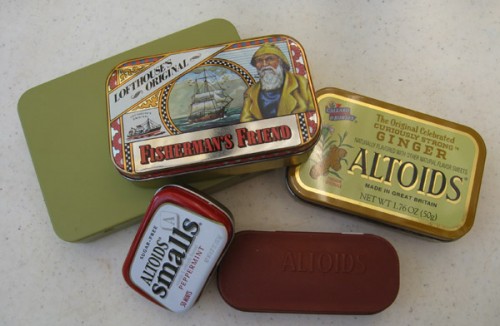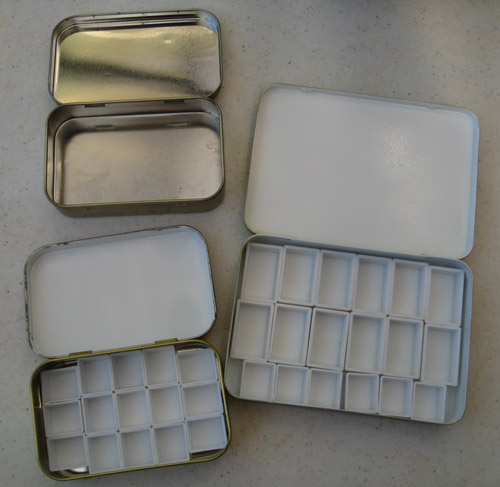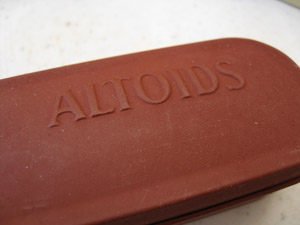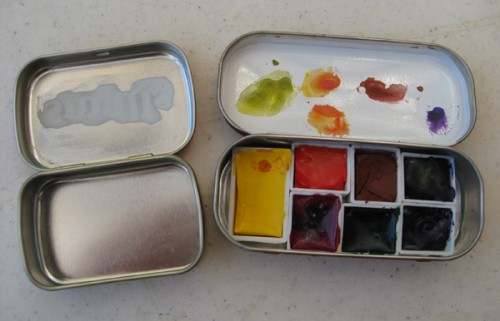Tweaking Tiny Tins: making mini watercolor kits from mint boxes
2d update, April 2015, about using magnetic tape to secure pans to Altoids tin, see comments
Updated 19 May 2013 (see link at bottom of article)
Everybody in the world has posted their version of the Miniature Watercolor Box, usually ingeniously created from any flat metal tin, often Altoids, sometimes Velamints, or others (see here, here, and here, just for a few examples of many). These projects are all well-described and illustrated. I hereby add my version, but will only add a couple of tips I think are an improvement on what others have already shown.
As a hiker/backpacker, I’m always looking for a way to carry along sketching and watercolor or gouache supplies that doesn’t take up too much volume or weigh too much. (Or cost too much: commercially made ones are available at artist’s suppliers but seem exorbitant, if pretty cool.) Not all hikes yield usable painting or drawing time, and I want to carry something that I won’t begrudge space to if I don’t get around to using it. So I was enthralled by the mint-tin plein-air kits I saw on the Web. It’s just the kind of project to seize my imagination, so off I went. Which brings up the first tip: if this is your kind of project, beware taking up more time constructing your kits (or posting about them!) than painting with them — and I speak from experience — it’s easy to go there. Although, the preparation can be big fun and have its own rewards.
Not all hikes yield usable painting or drawing time, and I want to carry something that I won’t begrudge space to if I don’t get around to using it. So I was enthralled by the mint-tin plein-air kits I saw on the Web. It’s just the kind of project to seize my imagination, so off I went. Which brings up the first tip: if this is your kind of project, beware taking up more time constructing your kits (or posting about them!) than painting with them — and I speak from experience — it’s easy to go there. Although, the preparation can be big fun and have its own rewards.
The basic idea is to use empty, flat, metal boxes (such as those in the top photo in various stages of the process) to carry small containers (like contact lens cups, or polymer clay depressions, or purpose-made watercolor half-pans) filled with tube watercolors pre-squeezed out into them and allowed to dry. The dried colors can be re-wet and used to paint, just like commercially available pan watercolors. But with a customized mint-tin box, you can choose your own brands and colors, or easily switch them out for landscape, botanical, or portrait projects — whatever you like.  (Second tip — don’t glue your pans permanently in place, as some folks recommend. If they’re inconveniently loose, fasten them down with something temporary, like double-sided tape or that gummy product they sell; or, wedge them in with a bit of sponge or paper towel, which would be useful anyway for blotting. You want to be able to take them out to change or clean.) Many people like to accompany these tiny paint-boxes with water-brushes like those made by Niji and Sakura, which have water reservoirs in their barrels, so they don’t have to carry extra water in a bottle. (The photo on the right shows the insides of boxes in various stages, the top one awaiting enameling, the other two enameled and awaiting paint selections.)
(Second tip — don’t glue your pans permanently in place, as some folks recommend. If they’re inconveniently loose, fasten them down with something temporary, like double-sided tape or that gummy product they sell; or, wedge them in with a bit of sponge or paper towel, which would be useful anyway for blotting. You want to be able to take them out to change or clean.) Many people like to accompany these tiny paint-boxes with water-brushes like those made by Niji and Sakura, which have water reservoirs in their barrels, so they don’t have to carry extra water in a bottle. (The photo on the right shows the insides of boxes in various stages, the top one awaiting enameling, the other two enameled and awaiting paint selections.)
I don’t think I’m the only one who’s been saving metal Altoids tins for years with the idea that some day they’d come in handy. Well, this is that day. It turns out the older ones are best — the ones with the flat lids, without the product name embossed in the lid (like the one below on the left, painted with a red anti-rust primer). The embossing is fancy, but since the inner lid becomes your mixing surface, a flat one is better (more about fixing that in a minute).
The inner lids of most brands are silver like the top one in the photo above — those are usable, but it’s easier to see your colors if you’re mixing on white. Some tins are already white inside. A few folks have inserted a portion of a plastic mixing tray here; good, but there’s both extra weight and extra work to cut it out of an existing watercolor palette (although you do get to wield your Dremel tool). Others spray paint the surface white. That’s the solution I went with, but here’s my next Valuable Tip: don’t just use white spray paint, use spray-on Appliance Enamel, found with the spray paints at hardware or DIY stores. It’s perfect — stain  resistant, glossy, very white, quick drying, and rust proof. It was miraculous to watch a metallic surface become pure white, shiny, and even in just 2-3 coats. I couldn’t stop using the stuff — the cats were lucky they didn’t end up slick and white. Don’t forget to mask the outside with some tape before spraying. If you want to obliterate the product labeling on the outside of your tin, use regular indoor-outdoor spray paint for that — I’ve been doing that after spraying the inside (mask it so that slick white surface isn’t contaminated).
resistant, glossy, very white, quick drying, and rust proof. It was miraculous to watch a metallic surface become pure white, shiny, and even in just 2-3 coats. I couldn’t stop using the stuff — the cats were lucky they didn’t end up slick and white. Don’t forget to mask the outside with some tape before spraying. If you want to obliterate the product labeling on the outside of your tin, use regular indoor-outdoor spray paint for that — I’ve been doing that after spraying the inside (mask it so that slick white surface isn’t contaminated).
Next tip, about indented lids: if you have an embossed tin lid, your mixing surface will have dents that cause color mixtures to pool. If this bothers you, start by filling these dents on the inside of the lid with a waterproof product. I use a modeling product called Apoxie Sculpt. Just follow the instructions; you can smooth it out with a wet fingertip and then sand when dry. Polymer clay would work as well, but needs to be oven-cured. Remember to do your infilling before using the Appliance enamel. This adds a level of complication to the project, both because of having to do the leveling and procuring the product, but I know your ingenuity is up to it. If not, just forget it and find a non-embossed tin — they’re out there, but not Altoids, I don’t think — or, use the embossed lid anyway. It’s not the end of the world. (The photo on the right, below, shows an embossed lid box filled and awaiting enameling, the other box is complete; it’s the rust-colored Altoids gum box above — you can see that the indentations of the lettering have been filled and the lid now has a smooth mixing surface).
Where to put the paints. Since I don’t wear contacts lenses and don’t have access to old lens cups, I was going to make my own half-pans with polymer clay to hold the paints, but I found I didn’t have the patience to make as many as I would need. Using a solid pad of clay and making paint depressions in it is a good solution, but not for me: I wanted to be able to change out individual colors. So I went for purpose-made plastic watercolor pans and half-pans, which wedge snugly into mint tins in various combinations. Unfortunately, I found that individual empty pans are not easy to find, currently. Jerry’s Artarama has them in their catalog, but as long as I’ve been working on the project, they’ve been out of stock. I finally found another supplier, Natural Pigments, a cool vendor in Willetts, CA, who specializes in pigments and supplies for people making their own paints. They have empty pans available for a good price, but frankly their shipping fees are mysteriously high for such lightweight items. Still, beggars can’t be choosers, and that’s who I’ve been buying from. Consider that another hot tip, with a caveat (shipping price).
Now you’re ready to configure your pans geometrically in your prepared tin, and select your palette — both tasks similar to scattering rice in front of a vampire: there are those who obsess on these things. I won’t presume to dispense advice on color choice, but just a warning: the smaller the tin, the fewer your colors, the harder the choice, for most.
Let me finish off by saying that if this is the kind of project that floats your boat, there are many possibilities: different sizes of tins (to accommodate larger and smaller palettes); traveling tins for gouache (non-acrylic gouaches are re-wettable like watercolors and like them can be squeezed into pans and allowed to dry); and gifts for artist friends, with or without the paints (some artists are picky about their color choices). Now that Altoids has introduced Smalls, there’s a Really Tiny Tin to challenge your minimalist palette selection. And finally, modern mint-boxes are great, but how cool would vintage metal boxes be?! I’m thinking Kiwi shoe polish, for one…
Update: Here’s another artist’s traveling pastille box, with plastic caps for pans. What a great idea!

Scattering rice in front of a vampire!
I love this idea, and I think your version is my favorite. Getting back into painting, and I think a little kit like this will help!
Daniel Smith sells empty, individual pans.
CP — It’s been a while since I posted this, and it happened to be a time when some of the suppliers were out. I’m sure empty pans are once again available more widely, at Daniel Smith as you mention, and also at Kremer Pigments. Thanks for the update!
This is such a great idea. I’m using a square antique cigarette tin!
Love this idea! I was looking around for what to use to hold the paint, and I stumbled upon a perfect solution…..after you use chewing gum that comes in the plastic tray “bubbles”, you have a clear, plastic set of 8 wells that fit perfectly in an altoids container 🙂 Thanks for project — I am going hiking and needed a new travel set.
Sounds great! Thanks for posting the gum-bubble tip!
Oh my, you can also stack them for two trays of color, or use them for mixing trays 🙂
Cheap Joe’s has the empty pans also. I made mine using water bottle caps, 6 for a dollar @ dollar tree My boss was throwing away magnetic cards so i upcycled them. I glued the magnets to bottom of the caps. then i cut up a old plastic basket to fit lid for mixing glued it to lid and a piece to fit in box to cover paints “pans” and giving me a place to hold other stuff or u could stick 6 more caps with blue tac and have 6 more colors
Glad to hear Cheap Joe’s is carrying empty pans now; back in the day when I originally posted this, they seemed to be permanently out of stock. Also, great idea to use magnetic cards to stick the pans in!
[…] Tweaking Tiny Tins: Making Mini Watercolor Kits from Mint Boxes […]
What appliance enamel do you use? I tried Rustoleum appliance epoxy in gloss white, but the surface is not as smooth and glossy as I would have liked. Thanks for your tips!
Jill, I used Ace Hardware Appliance Epoxy. The smoothness issue you’re noting could be brand-related, or it could be application-related, such as temperature, or thickness of each coat, etc. The Ace product has worked for me, although over the years (since I wrote this post), flexing of the metal lid — usually due to being crushed in a pack — has caused cracks in the epoxy, which in one case did result in flaking off in small places. Annoying, but still usable. I could repair it with white Apoxy, also a great product. Glad you’re getting use from the info, good luck and good painting!
Thanks Allison, I will experiment with what I have, then move onto your suggestions!
Tops of pop bottles, Legos upside down, or cheap set dump cheap watercolor make good holders!
Hi.. love your idea! The question I have is a general one, but appropriate for the enamel spray… why would you want it smoothe? I’ve just started watercoloring, and I’m finding that mixing colors on smooth plastic palettes is almost next to impossible, in that you can’t get the colors off your brush onto the plastic.. it’s too smooth and just rolls around.. how do you get the water/colors off your brush and onto the palette? Thanks!
Does the watercolor paint bead much on the enamel paint surface?
At first it does, but with more use it beads less. I think it’s because with time microscratches from use and cleaning and also residue make the enamel paint less slippery.
Well, smooth is relative. Mostly I’m trying to even out any irregularities in the original metal lid, like embossed lettering if any. But the main reason is that it’s easier to clean if the mixing surface isn’t nubbly or textured. Deep irregularities can either aid or hinder loading a brush. But, it’s whatever works for you, for sure!
All great ideas!
Do you think few coats of gesso would work to fill in the indentation? Or to simply fill it in and then spray it?
Or maybe it’s possible to fill the indents with silicone?
An alternative to painting the lid and mixing on it is to get some thin, cheap, flexible cutting boards. You can get them in white but I get transparent ones 2 for a dollar at dollar tree. Cut a piece to fit the inside of the lid. You can paint the backside of it or put some white paper behind it. Then, you can either glue it permanently or you can use something less permanent, like double-sided tape or glue dots…anything that will hold it in place but allow you to pull it out later. The advantage to that is that after awhile it will be pretty stained, like the paint and plastic palettes will do, and this will let you remove it, give it a clean and then replace it with another piece. You also won’t have to fill in the logo indents. The old piece can then be used as a cover over your paints in case you don’t have time to let them dry before closing it, or to carry a second layer of…whatever you want!
Sorry to resurrect a dead thread but I’m obsessed with making kits…I definitely have the problem of wanting to spend more time making them than actually using them, lol. I have a ton not including the ones I gave as gifts and a ton more in progress because I’m always tweaking them. Just bought a new tin to use tonight, as a matter of fact. Someone send some intervention! 🤣
These are all excellent ideas, Yaakov, thanks for adding to this thread. I totally get spending more time engineering tiny tins than using them! Also, it makes me laugh that the post on Three Star Owl blog that’s been the busiest is about painting — and me a clay artist! To add to your idea of a removable, replaceable palette, the art stores (Blick for sure, probably others) sell a plastic poster board more cheaply than the flexible cutting boards (which are affordable already). With either, you can run a silicone bead around the edge which gives you a pan effect, and lessens the run-off of wet color over the edge of the palette.